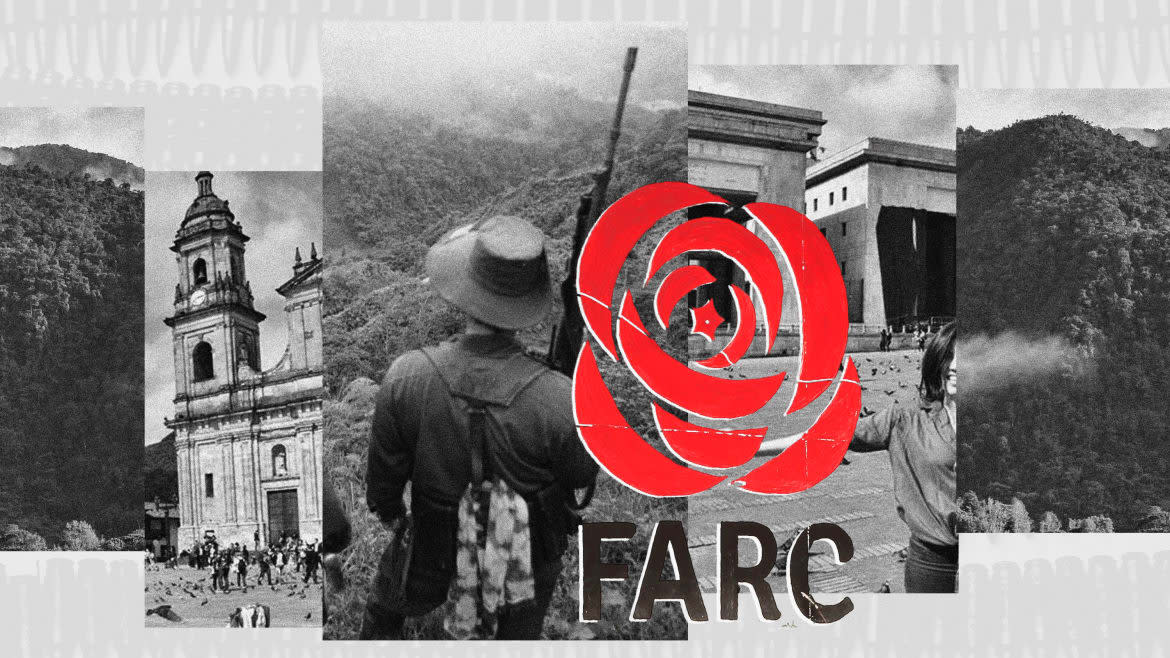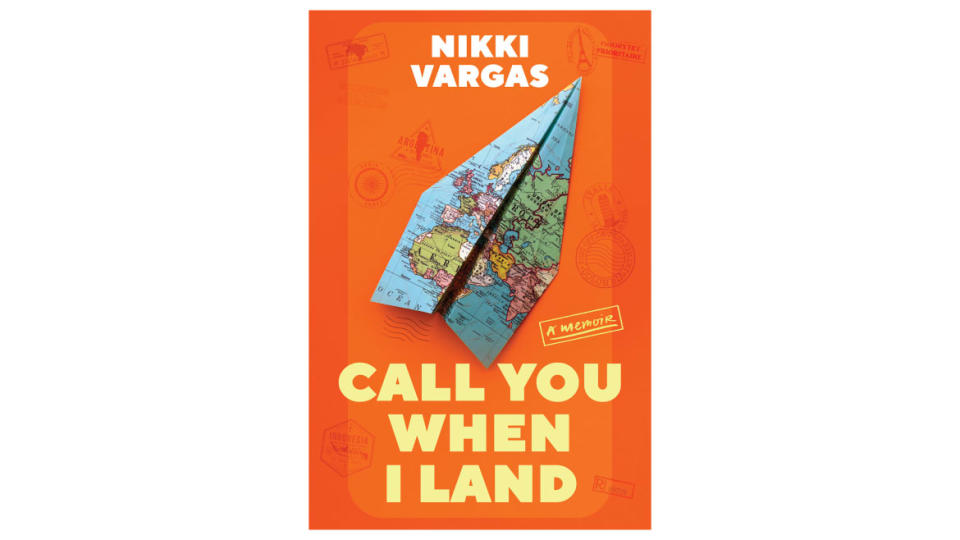Going Face-to-Face With the Terror Org That Killed My Aunt

- Oops!Something went wrong.Please try again later.
The following is an excerpt from author and travel editor Nikki Vargas’ new book, Call You When I Land, out Nov. 7 via Hanover Square Press.
I’ve never been to this part of Bogotá before. I’m somewhere on the outskirts of the city, where the neighborhood streets are dirty and dusty, covered with a layer of beige soot that kicks up each time the wind blows. The sidewalks are empty, the doorways are darkened, and the windows are covered by metal bars—all of it giving the sense we’ve landed in some post-apocalyptic neighborhood.
I’m sitting in a black SUV with two men: my driver and fixer. Fixers are vital to reporters; they’re on-the-ground contacts who help foreign journalists arrange interviews, gain access, and get the information needed to write a story. My fixer, José, is a young and eager journalism student I was referred to back in New York when researching fixers. My driver is Alejandro, my grandma’s go-to Uber driver.
For the past week, I’d been staying with my grandma, Clarita, who is a wild and, at times, outlandish woman living out her golden years with the same energy as a twenty-one-year-old on spring break. When Clarita loves something, she takes it, and so Clarita pulled Alejandro right off Uber, offering him money to be her personal driver. I turn towards Alejandro now, who is looking warily around the sketchy street. Clearly, he got more than he bargained for with today’s ride.
José and I jump out of the car and amble towards a commonplace building with black bars placed over the windows and doors. One knock and the metal door swings open to reveal a stoic-looking security guard wearing all black.
“Si?” he asks with a deep grunt.
Before I can respond, my fixer springs into action, explaining in rapid-fire Spanish that we’re here for a media interview. The guard nods and gestures for us to step inside. A dark hallway leads to a glass-encased conference room in which a young woman sits motionless, waiting beneath fluorescent lights, her eyes staring blankly at the rectangular table in front of her.
Flora—who opted to go by a pseudonym—can’t be more than thirty years old. Her face is round, and her hair, which is cut into choppy layers, is streaked with red-and-purple highlights framing her face. She is wearing a dark hoodie with her hands sunken into the pockets, as if she’s trying to disappear into the folds.
Flora is hardly intimidating enough to warrant such security, but then again, I remind myself just who it is I’m speaking to. Flora is an ex-FARC fighter, as in, the guerilla group that killed nearly 260,000 people across Colombia, as in, the guerilla group that may have murdered my great-aunt, Adita.
“Thanks for talking to me today. I’m going to be recording this conversation,” I say, gesturing toward my iPhone lying on the table.
As José begins translating my words, Flora nods nervously, her eyes never leaving the surface of the table, her hands still plunged deep into the pockets of her hoodie. Flora is undergoing a reintegration process, a controversial program that has been put into effect following a historic peace deal signed by President Juan Manuel Santos and the FARC, transforming this once-deadly narco-terrorist organization into a political party with guaranteed seats in the Colombian congress and senate.
The peace deal—which was voted against by the majority of Colombian citizens—has drawn intense criticism for its leniency towards the FARC, creating a fiery debate about what is more paramount: obtaining justice or having peace. At the center of this hot-button issue sit people like Flora, who have spent their entire lives living in the FARC camps hidden inside Colombia’s jungles.
Right away, I’m nervous. I think back to my childhood and how the acronym FARC came to represent so much misfortune in my family. I think back to a few days ago when I met with Margarita, one of Adita’s surviving daughters. Margarita showed up at my grandma’s apartment wearing a white button-down blouse tucked into a pair of slim-fitting blue jeans. Her near-perfect English was heavily accented as she began to tell me about my great aunt, slowly unraveling the knotted threads that had surrounded her murder.
Once upon a time, Adita had been a dentist and a painter who lived in the beachside town of Santa Marta with her husband, whose family owned a massive plot of farmland that had been passed down from generation to generation. Back in the day, this farmland had been used for all the usual things—growing crops and raising cattle—but was one day overtaken by FARC guerillas who invaded the property and claimed it as their own. Slowly, the FARC began to sell off pieces of the land to other buyers, using the profits to finance their illicit activities.
Adita’s husband—a lawyer, at the time—tried his best to get his family’s farmland back. As he proceeded to navigate a corrupt legal system, an on-paper battle between his family and the invading guerillas was created. As Margarita explains, the FARC took that fight right off the page and sent threats to Adita’s husband, shooting him (nonfatally) and scaring him just enough so that he never returned to the farm again. Once he eventually passed away, Adita decided to resume her late husband’s work and get the family land back by evicting the FARC from their property. This is where an already complicated story becomes more convoluted.
“I was talking with my mother,” recalled Margarita, sitting on my grandma’s cream-colored couch. “She told me she was going to try and talk to this man and agree on something soon.”
“This man” was apparently a nearby landowner who had allegedly purchased a plot of Adita’s land from the FARC illegally and was abhorrent at the prospect of giving it up.
This is where the theories begin to swirl. All we know for sure is that one morning, Adita was kidnapped and taken to the Sierra Nevada mountains, where she was killed and found hours later.
“It was a very big rock that they used,” said Margarita flatly, her eyes far away, remembering how she’d had to identify her mother’s body, noting the trauma to her head.
I had finally learned how and why Adita had been killed, but the question of who did it remained unanswered. In the immediate aftermath of her murder, the landowner was never questioned, and to layer in more mystery, Adita’s kidnappers turned up dead. These facts just bred more questions. None of it made sense, and perhaps it never would. And, just like that—as has so often been the case in Colombia—my great-aunt’s death was swept under the rug.
“Do you blame the FARC?” I asked Margarita, wondering if she, too, saw them as the big bad wolf.
“Some people in Colombia just do what they want.” She sighed. “The laws are so soft, and there is no punishment.”
I think of these words now as I sit opposite Flora.
“Okay, let’s begin.” I nod toward José to signal the start of the interview. “Let’s start with how you came to join the FARC?”
José snaps into action, translating the question.
“Many young people decided to enter into the FARC because they didn’t have other opportunities,” explains Flora, shifting uncomfortably in her chair. Her voice is a near whisper, as though she were a child being reprimanded for bad behavior.
As she speaks, I’m a little surprised to feel a pang of sympathy. Flora’s early life—like that of so many other child recruits—had unfolded within the guerilla group. In Colombia’s jungles, she had her first period, fell in love, lost her virginity, and even gave birth to her first child (a baby she promptly had to give up due to the FARC’s strict rules against soldiers having children). I had come to today’s interview expecting a villain, but am instead met with a wide-eyed woman, desperate to reconnect with her now fourteen-year-old daughter.
The half hour interview passes quickly, and soon enough, José and I are walking back onto the dusty street towards Alejandro and that black SUV. A few days ago, while having dinner in downtown Bogotá with some relatives, I learned of the term “Locombia,” which combines the word loco (crazy) with Colombia, used to describe the chaos of the country.
Walking away from my interview, I think of this term now and the stories I’ve uncovered during my trip here: a child being inducted into a terrorist organization; a woman being murdered for trying to take back what is rightfully hers. There is just no rhyme or reason to my homeland. In my own writing, I love to have those perfect endings that tie everything together in a way that leaves no stone unturned. But by the time I leave Bogotá, theories about Adita’s murder unravel. I must learn to live with the unfinished story.

Get the Daily Beast's biggest scoops and scandals delivered right to your inbox. Sign up now.
Stay informed and gain unlimited access to the Daily Beast's unmatched reporting. Subscribe now.

